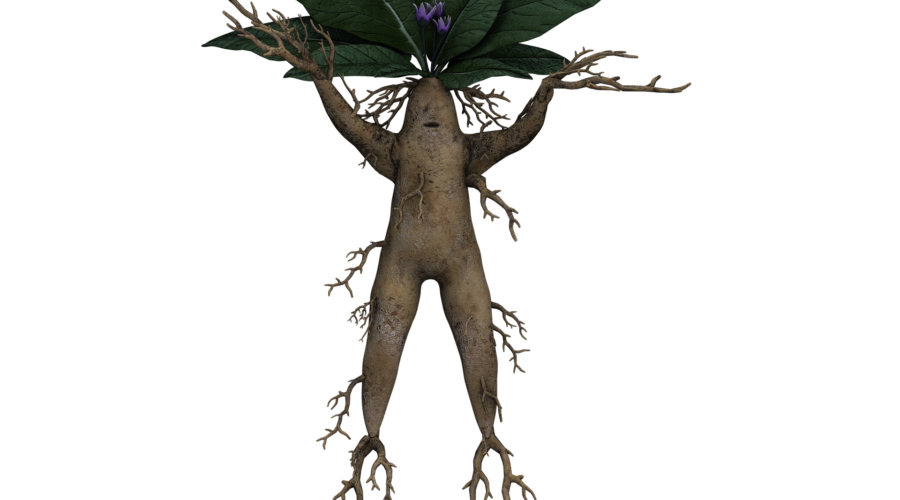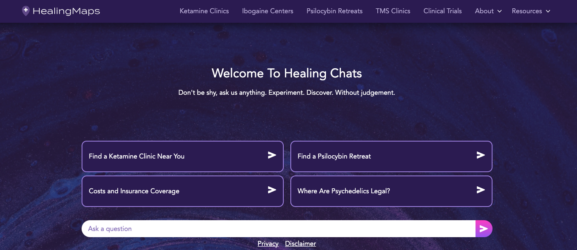Mandrake Root: Healing, Harming, And Magical Properties
Mandragora officinarum. A poisonous plant that supposedly utters a deathly scream when you pull it, draws a beloved to you, protects you from demonic influences, and can bring inner peace. And, a plant that most people know about from Harry Potter. The storied mandrake root has deep roots in our collective imagination. Documented use hails back to Antiquity, when it was used as a weapon, a surgical anesthetic, a fertility treatment, and an aphrodisiac.
While it is not commonly used medically now, interest has risen in the mandrake as a magical, poisonous, and potentially psychoactive plant. Why does mandrake root continue to enthrall us in both fiction and reality, and what are safe ways to work with this evocative plant?
RELATED: Do Shrooms Show Up On A Drug Test?
All In The Family
The mandrake root is part of the Solanaceae family, commonly known as the nightshades. This family contains some of humanity’s most beloved food crops, like tomatoes, potatoes, and eggplants, as well as some of its most poisonous, like deadly nightshade, jimsonweed, belladonna, and henbane. (Tobacco, a poisonous plant that has also been utilized as a ceremonial and cash crop, is another famous family member.)
Both the toxic mayapple (Podophyllum peltatum), which is native to North America, is sometimes called the American mandrake, but is not the same species as Mandragora officinarum.
Native to the Mediterranean, the mandrake root has large rosette leaves and produces violet flowers and small berries, which were reportedly eaten cooked or raw as a delicacy. The large and tuberous mandrake taproot, which can reach up to two feet in length, is often forked, a feature that occasionally makes it look humanoid in form. Some sources even posit the existence of “male” and “female” mandrakes.
RELATED: Best Kratom Powder Of 2022
Mandrake Root In Early Modern History And Culture
With use documented as early as the 15th century B.C.E., mandrake is mentioned in ancient texts from Egypt, Mesopotamia, and the Roman and Greek Empires. In Homer’s Odyssey, the witch Circe uses a brew made from mandrake to transform Odysseus’ crew into swine. The Greek physician Dioscorides first recorded its use as an anesthetic in the 1st century C.E.
Pictorial renditions of mandrake also decorate Egyptian tombs, where it was used as a funerary and, perhaps, a shamanistic plant. The Biblical Books of Genesis and Song of Solomon mention mandrake for its supposed properties as a fertility treatment and an aphrodisiac (another name for its fruit is the love apple).
Mandrake root’s reputation persisted well into the Middle Ages, when it was thought to be a panacea. In a medical world ruled by the doctrine of signatures, which posited that a plant’s use can be inferred by what it resembles, the mandrake’s similarity to the human form lent credence to the belief that it could be used to influence and control people.
Possessors of mandrake roots also sometimes saw them as potential hosts of spirits, homunculi that could be given offerings to bestow blessings upon their owners.
Uprooting mandrake was a supposedly deadly business, because the sought-after root would utter a terrible scream that killed anything near it. For that reason, strange practices, to combat the lethal screams, including leaving a dog tied to the plant at night. When the dog pulled the root from the ground, the scream would kill it, rendering it safe for collection.
Earlier Stories About Mandrake
An earlier version of this story from the 5th century C.E. notes that the plant kills the first thing that touches it. (Spoiler alert: the dog still dies.)
By the 15th century, finding mandrake had become even more challenging. Contemporary stories posited that mandrake grew under gallows, springing up where the waste from hanged men fell.
Rebecca Beyer, author of Wild Witchcraft: Folk Herbalism, Garden Magic, and Foraging for Spells, Rituals, and Remedies and founder of Blood and Spicebush School of Old Craft, shares one potential reason for the near-impossibility of gathering mandrake root.
“There are some legends that due to mandrake’s popularity, sellers and diggers invented the story that mandrakes would scream a deadly scream when plucked from the ground, killing the harvester,” she says. “There are also stories of those who harvest mandrakes being thrown high into the air! Many historians have examined these stories, and my favorite explanation is that it was a seller’s folktale to protect their harvest,” which could fetch such a high price that counterfeits were common.
Mandrake root began to fall out of fashion in the 16th century as other pain relievers and anesthetics became available, and as scientists derided its supposed magical properties. Over the next few centuries, it fell into relative obscurity.
RELATED: Mio’s Story: How Psilocybin Therapy For End-Of-Life Anxiety Helps To Treat The Whole Person
“Ten Points To Gryffindor”: Mandrake In The Harry Potter Series
Mandrake root once again captured the public imagination with the publication of J.K. Rowling’s Harry Potter and the Chamber of Secrets in 1998.
Treatment of mandrakes in the series aligns with folkloric and magical texts on the plant, with some embellishments. Second and third-year students in Herbology at Hogwarts School of Witchcraft and Wizardry work only with immature mandrakes, whose screams are incapacitating, but not deadly (the young students have to wear earmuffs to block out the sound). The mandrakes are also homunculi, who mature like humans, even going through a sullen and rebellious teenage phase and breaking out in acne.
Mandrake is also the key ingredient in Hermione Granger’s Mandrake Restorative Draught, which she uses to revive victims of petrification during the Chamber of Secrets openings.
The 2002 film adaptation grossed $879 billion and brought mandrakes to an even larger audience. After centuries in the shadows, mandrake reclaimed the spotlight in a new millennium — and Rowling sometimes got credit for inventing them. Beyer notes that she often corrects people who think they were invented for Harry Potter and are fictional plants. “It’s always funny to let people know [that] in fact their lore is real and stems from classical history.”
RELATED: CBD & Kratom
Mandrake Root’s Medicinal And Psychoactive Uses
Every part of the plant contains the alkaloids scopolamine, hyoscyamine (its biochemical precursor), and atropine, among others. All have been used historically for myriad reasons, including their anticholinergic and psychoactive effects.
Hyoscyamine, an antiemetic, antispasmodic, and antisecretory, slows the motion of the stomach and intestines, as well as the production of stomach acid and saliva, is most commonly used to treat GI tract disorders but is also prescribed for Parkinson’s, irritable bowel syndrome, and allergic rhinitis, among others.
Scopolamine can be given as a transdermal patch to treat nausea or motion sickness. It is also used as a deliriant that, when blown into a victim’s face, makes that person highly submissive and compliant (a reason that its street name is “Devil’s Breath”). In doses high enough, both alkaloids can cause coma and death.
Atropine is used for pupil dilation, arrhythmia, and as a treatment for the ingestion of toxic cholinergins, including mushrooms. It gave Solanaceae family member belladonna its name after Roman women used the tinctured plant to dilate their pupils and make their eyes more attractive (large pupils were a standard of beauty at the time).
In doses high enough, these alkaloids can lead to anticholinergic poisoning, which can result in hyperthermia, rhabdomyolysis, delirium, visual hallucinations, disability, and death.
RELATED: How To Lucid Dream
How To Work With Mandrake Root
Beyer recommends that people reconsider before ingesting mandrake root. “I think it is safe in small doses personally to use it externally, but I would advise against it internally especially if you may have an underlying liver issue,” she says. “The solanaceae family is nothing to mess with, and though this root is less poisonous than other relatives like Belladonna, I still advocate caution.”
Instead, she recommends cultivating it for magical use.
“Growing and tending these difficult-to-cultivate plants is a wonderful way to make a connection with them that does not involve risking your health,” she says.
Beyer notes that while mandrake is poisonous, it was also used historically in preparations that were consumed. “The dose makes the poison,” she says.
Seamus Black, founder of Emporium Black, creates truffles with plants from the Nightshade family. Three types of truffles that include mandrake are currently available.
Black, who has carefully created the recipes for truffles on the site, shares that when people ask for advice on using mandrake on their own, “my stock answer is [that] as far as tips and dosage there are far too many variables to establish what would be safe for most people to do on their own at home. There is an area where these plants can be effective entheogens, but going over that amount can have much more serious consequences than most other entheogens.”
However, he notes that mandrake root’s diabolical reputation is largely undeserved, and that there is much to learn from this and related plants. “I think there are a lot of misconceptions about mandrake as well as the other nightshades I use,” Black explains. “It breaks my heart to see them so misrepresented. They are most frequently portrayed as dark, dangerous, and deadly. They are referred to as poisons even by so many people who seem to love them and focus their own paths on them. … To me they are sacred plants for healing.”
What A Mandrate Root Experience Feels Like
Black describes the experience of consuming truffles as gentle and healing, suggesting the starting dose is half of one truffle. He notes that over 16,000 truffles have been sold with no reported ill effects. There is not enough of any ingredient to make someone high.
“We all know that many things are poisonous if we consume too much and we don’t call them poison,” Black adds. “In fact we frequently call them medicine…healing medicine even. There are so many much loved plants and flowers in the world that are toxic that we love to keep in our gardens and homes that we enjoy without them having that heavy stigma of being a poison. These nightshades are like the elders our culture has lost touch with. I find it interesting that these plants that can help our culture find our way back and help us find true healing are the very plants that we in turn labeled poison and propagated endless tales to support a dark and nefarious nature to them. We are pushing away what we need most, but it is of course being done unconsciously.”
In Indigenous communities, Black shares, “everyone doesn’t just go and grab entheogens … on their own and have their own ceremonies like everyone is their own personal shaman. You go and make offerings to the healer/medicine person in the community who specializes and is known for that kind of medicine. They would never just give you the medicine to go take and do with as you wished.”
“This is missing in our culture,” Black adds, “and so we get people recklessly eating datura pods, gulping down peyote and whatnot under the feigned guise of spiritual enlightenment. We are missing that part where maybe we don’t know best. Maybe we need some guidance and maybe that doesn’t have to be a blow to our ego. Reading a few articles doesn’t make us elders or experts. It’s a strange time we live in, but I think this is a large part of the problem.”
RELATED: What Is Kratom Tea Good For, And How Do You Make It?



